

| Flatworms in Nottinghamshire |
| ... |
|
Innumerable pages on this website have often opened with a statement
describing how little is known about the status of a particular
species, Family or Order, but its a statement which certainly
applies to Flatworms in Nottinghamshire. Certainly on both past and present evidence, we probably know nothing of what species we have here, how common they are, or where they actually occur. And the evidence from the hours of research put in, reveals that Flatworms appear to be much less common than might be thought. There again, many people will likely never have heard of Flatworms. |
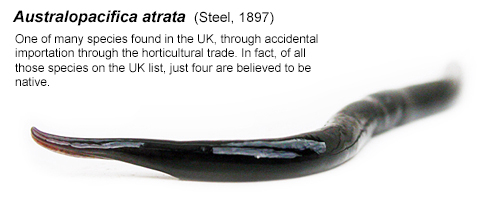 |
|
| ... | ||
|
It was a chance discovery at Woodthorpe Park in Nottingham that's
the reason for this page, when some strange, completely black
invertebrates on the underside of some large logs alerted my
inquisitive side. So I took a couple of record photographs and made
my way home to try and identify them. Somehow, I ended up looking at Terrestrial Flatworms (Platyhelminthes) which does include some aquatic species, but this page (and my own interest) ends firmly at the edge of the water. Terrestrial (or land) Flatworms are often called Planarians and information about them on the internet is pretty slim. |
||
| ... |
|
UK Terrestrial Flatworms The following is a list of Terrestrial Flatworm species with UK records. It's been difficult to compile as there is so little information out there and trying to determine the current nomenclature is difficult. Most of the species names are taken from the NBN (National Biodiversity Website) Atlas. If there are any mistakes (and I assume there is) please let me know, but I will be making attempts to sort any discrepancies out. |
| ... |
| Family: Geoplanidae Stimpson, 1857 |
| Subfamily: Bipaliidae Stimpson, 1857 |
| Genus: Bipalium Stimpson, 1857 |
|
Bipalium kewense
(Moseley, 1878) |
| Subfamily: Geoplaninae Stimpson, 1857 |
|
Genus: Obama Carbayo et al., 2013 |
|
Obama nungara
Obama Flatworm
(Carbayo, Álvarez-Presas, Jones & Riutort, 2016) |
| Subfamily: Microplaninae Pantin, 1953 |
|
Genus: Microplana Vejdovsky,
1889 |
|
Microplana humicola
(Vejdovsky, 1890) |
|
Microplana kwiskea
Jones, Webster, Littlewood & McDonald, 2008 |
|
Microplana scharffi
(Graff, 1899) |
|
Microplana terrestris
(Müller
OF, 1773) |
| Subfamily: Rhynchodemidae Graff, 1896 |
| Genus: Arthurdendyus Jones 1999 |
| Arthurdendyus albidus (Jones & Gerard, 1999) |
|
Arthurdendyus triangulatus New
Zealand Flatworm (Dendy, 1895) |
| Genus: Artioposthia Graff, 1896 |
| Artioposthia exulans (Dendy, 1901) |
| Genus: Australopacifica Ogren & Kawakatsu, 1991 |
| Australopacifica atrata (Steel, 1897) |
|
Genus: Australoplana Winsor, 1991 |
|
Australoplana alba
(Dendy, 1891) |
|
Australoplana sanguinea
Australian Flatworm
(Dendy, 1891) |
| Genus: Kontikia Froehlich,1954 |
| Kontikia andersoni (Jones, 1981) |
|
Kontikia ventrolineata
(Dendy, 1892) |
|
Genus: Dolichoplana Moseley,
1877 |
|
Dolichoplana striata
(Moseley, 1877) |
|
Genus: Rhynchodemus Leidy, 1851 |
|
Rhynchodemus sylvaticus
(Leidy, 1851) |
|
Genus: Caenoplana Moseley, 1877 |
|
Caenoplana variegata Southampton Flatworm
(Fletcher & Hamilton, 1888) |
|
Caenoplana coerulea
(Moseley, 1877) |
|
Genus: Marionfyfea Winsor, 2011 |
|
Marionfyfea adventor
(Jones & Sluys, 2016) |
|
Genus: Parakontikia Winsor, 1991 |
| Parakontikia coxii (Fletcher & Hamilton, 1888) |
| Genus: Platydemus von Graff, 1896 |
| Platydemus manokwari De Beauchamp, 1963 |
|
More about Flatworms
Terrestial Flatworms belong to the Phylum Platyhelminthes, which includes a number of aquatic Flatworms and the parasitic Flukes and Tapeworms. They are smooth and appear glossy, varying in size from 1.0cm upwards depending on species. All become much longer when moving. Flatworms are masters of changing appearance and are one of the UK's real 'shape-shifters' and quite amazing to watch. |
||
| ... | ||
|
Most are small and flattened,
often with a ribbon like appearance and covered in a sticky mucus,
with an unsegmented body which tapers towards the head. They have no
linear gut leading to an anus.
Flatworms leave a thin mucus trail behind them when moving, which can be an indicator to their presence at a site. During movement, the head is held off the floor and sometimes waved around in a snake-like manner. Those species native to the UK (in the Family Rhynchodemidae) all have just two eyes, which are typically difficult to see on dark coloured species, but the number of eyes varies in those harmful species now turning up here after accidental importation. All Flatworms are hermaphrodite, but perhaps the most incredible ability showed by some species, is the ability to multiply by fission. Fission is where the animal (or part of it) splits into two, with either section then growing a head or rear end and becoming separate individuals. The majority of species prey on earthworms, hence the seriousness of importing alien species into the UK. |
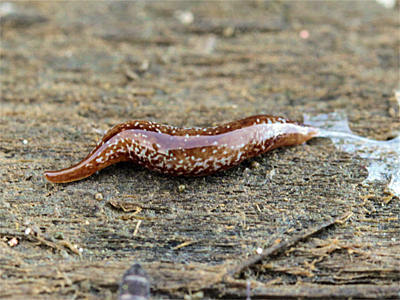 |
|
| Marionfyfea adventor (Photograph by Tim Sexton) | ||
| ... | ||
|
Nottinghamshire Flatworm records
There again, even the number of UK records seem few and this time, even J.W. Carr's book 'The Invertebrate Fauna of Nottinghamshire. Nottingham: J.& H. Bell Ltd (1916)' can't provide any help as there were no Nottinghamshire records even then. Carr does have a brief summary of Flatworms, which he ends with 'Nothing is known in Nottinghamshire of the free living Platyhelminthes, which offer a wide and interesting field for research. It is to be hoped that some local naturalist will take up the study of these animals, which are obviously of much greater importance for faunistic purposes, than the parasitic worms whose life history is so intimately bound up with that of their hosts'. Obviously nobody ever read Carr's book, or at least they skipped the Flatworm section and decided to skip straight to Bristletails! But it has to be said, that when you look more closely at Flatworms and do a little research, they do prove extremely interesting and we should take more notice of them, as many species prey on Earthworms and can potentially cause great ecological damage. |
||
| ... | ||
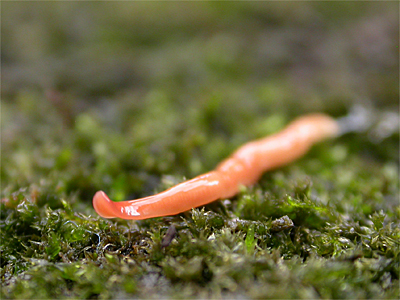 |
Records of any flatworm in
Nottinghamshire are still extremely few, with most of the eight known
county species being reported on just one or two occasions. All are
modern records, such has been the lack of interest showed in both our
native and non-native flatworm fauna, but
records are finally making it onto the NBN Atlas.
Marionfyfea adventor (Jones & Sluys, 2016) originates from New Zealand and is obviously another accidental import to the UK, via the horticultural trade. This tiny flatworm was recorded at Attenborough NR in December 2015 by Tim Sexton (See photograph above right), which, as of Febriary 2024, is still one of only two Nottinghamshire records. However, a more recent record comes from the Apleyhead Lodge area of Clumber Park and close to the A614 (the likely route of accidental introduction) where a second specimen was found in woodland by Nick and Samantha Brownley in February 2024, so this species certainly isn't confined to urban gardens. There are presently very few UK records. |
|
| Arthurdendyus triangulata (not illustrated) is the New Zealand Flatworm (Dendy, 1895) and is the only Nottinghamshire Flatworm record listed on the NBN Atlas. The record is from Worksop in 1993 and the four digit grid reference places it somewhere around Priorswell Road, near Worksop Priory and 'The Canch Park '. The record is typically rather vague, as there's no precise date (just 1993) and also no recorder or determiner name given. | ||
|
Australoplana sanguinea
is the Australian Flatworm
(Dendy, 1891) and a beautiful orange coloured species. There are now
three
Nottinghamshire known sites, with the first from a garden at Attenborough, when
found and photographed by Tim Sexton in May 2020. A second county record came
more recently, when one was found under black polythene membrane in a
plant standing area at a Worksop garden centre in early October 2021 (Pendleton,
T.). A number of other records have since followed and A. sanguinea
was by far the commonest of four species recorded at the site. Australopacifica atrata (Steel, 1897) is completely black, but grey with a thin dark stripe along it's length ventrally. Another Australian species and a recent arrival to the UK, first appearing in 2015 and with several records since. In September 2020, several of these were found in shaded conditions near the old walled garden at Woodthorpe Park (T. Pendleton) subsequently finding dozens of them underneath fallen peices of bark on a return visit. Small numbers were again present in early October 2021 and it was also found present at the same Worksop garden centre as A. sanguinea (T. Pendleton). A search at Woodthorpe Park in April 2023 only produced a single record. |
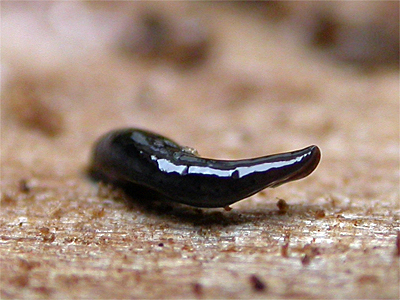 |
|
| Australopacifica atrata | ||
| ... | ||
| Obama nungara Obama Flatworm (Carbayo, Álvarez-Presas, Jones & Riutort, 2016) is a large, flat bodied species and difficult to spot against a dark soil background. What looks to be Nottinghamshire's first record was found under the black polythene membrane of a plant standing area at a Worksop garden centre in early October 2021, with a second record from the same site in April 2023 (both T. Pendleton). | ||
| ... | ||
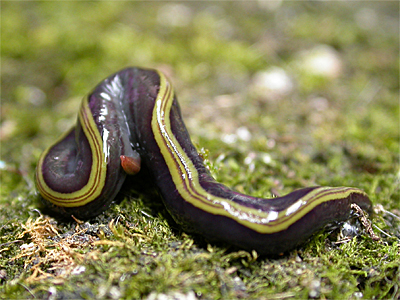 |
Rhynchodemus sylvaticus
(Leidy, 1851) is a pale brown coloured
Flatworm which is thought native to the UK. It is another species
recorded by Tim Sexton at Attenborough NR and was recorded in April
2017 and from a Worksop garden centre in October 2021 (Pendleton, T.A.). Caenoplana variegata (Graff, 1899) is known known more commonly as the Southampton Flatworm, has recently been added to the Nottinghamshire list with two records. One was found eating a wasp in the courtyard of Nottingham University's Life Sciences building in September 2021 (Thomas Hartman per Tim Sexton). But there have been two more recent records, both coming in quick succession from garden centres. One large adult measuring around 10cm in length, was found coiled underneath a section of railway sleeper at a Lambley garden centre in August 2024, and three were found together (including one adult) under a damp piece of wood, in an unheated greenhouse at a Normanton garden centre (Pendleton, T.A.). |
|
|
Microplana terrestris
(Müller
OF, 1773) is a brown species, which has only recently been
recorded from Nottinghamshire, despite it being regarded as the UK's
commonest and most widespread Flatworm. A specimen was found by Adrian Dutton, within a rotten log on Budby South Forest in May 2023 and there are Clumber Park records of five in two locations, found under logs in February 2024 by Nick and Samantha Brownley. Finding Flatworms in Norttinghamshire Because non-native Flatworms are arriving here through the horticultural trade, gardens and garden centres are probably the best places to check for them. They are usually found in shady and wet places on the soil surface, e.g. under flower pots, plant containers, tarpaulins and paving slabs etc. Because of the potential impact to both earthworm populations and those of other soil invertebrates, not-native Flatworms pose a great risk to both agriculture and horticulture. As such all non-native flatworms are included under Schedule 9 of the Wildlife and Countryside Act 1981, which states that it is an offence to introduce or release them into the wild. Additionally, the New Zealand flatworm is included in the Invasive Alien Species of European Union Concern list. Useful external links: https://www.record-lrc.co.uk/Downloads/5-2005%20-%20jones%20-%20british%20land%20flatworms[16012014].pdf wwwnonnativespecies.org. |
||
| Terrestrial Flatworm Photo Gallery - Thumbnail version |
| Insects |
| Homepage |